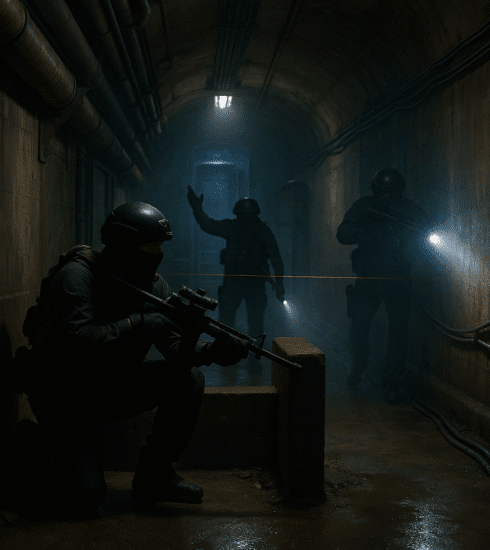How To Read A Room In Ten Seconds
Walking into a room quickly and understanding its dynamics is a critical skill. It is not about suspicion or fear. It is about awareness and preparation. This process is a systematic observation of people and their environment. You can learn how to read a room in ten seconds with a structured approach. It is a fundamental practice for personal safety and situational understanding. The goal is to gather information, assess normalcy, and identify potential points of interest or concern without drawing attention to yourself.
The greatest threat is the one you do not see. Your primary objective is not to find danger but to establish a baseline of normal activity. Any deviation from that baseline then becomes your focus.
The Three Second Threshold Scan
Your first three seconds are for the widest possible view. Do not focus on any single person or detail. Let your vision soften and take in the entire space. This initial panoramic scan captures the big picture.
Note the general layout of the room and its primary exits. Identify the main groupings of people and the overall noise level. This establishes the basic context for everything that follows. You are looking for the broad strokes of the environment.
Do not stop moving during this initial phase if you are entering. Your natural movement helps mask this observational process. The threshold scan is about absorbing the macro details. It sets the stage for a more focused analysis.
Calibrating the Baseline of Normal
A room has a rhythm and a sound that define its normal state. Your next step is to determine what that baseline is for this specific place and time. Listen to the general hum of conversation and observe the common body language. Most people will be engaged in their own activities.
This baseline is your reference point for the entire assessment. Anything that contrasts with this established norm warrants a second look. A person standing perfectly still in a lively crowd creates a visual anomaly. A sudden pocket of silence in a loud room signals a shift in mood.
Your own intuition is a tool here but it must be verified. A feeling of unease is a signal to look harder with your eyes. Do not dismiss a gut feeling but also do not act on it alone. Corroborate that feeling with observable facts from the environment.
Do not look for threats. Look for what is out of place. The man sweating in a cold room. The person standing who should be sitting. The eyes that meet yours a moment too long.
The Four Second Focal Point Assessment
With a baseline established, you now focus on specific points. Break the room into sectors and quickly scan each one. Look at individuals, especially those on the peripheries or alone. Pay particular attention to hands and eyes.
Hands tell you what a person is doing or what they might do next. Empty hands are a good sign. Hands concealed in pockets or bags require attention. This is a simple but effective rule for initial assessment.
Eyes will often tell you where a person’s attention is directed. A person scanning the room constantly might just be looking for a friend. Alternatively, they could be assessing the environment like you. The context of their behavior matters greatly.
Notice clusters of people and their dynamics. Are they relaxed or tense? Is their conversation open or hushed and secretive? Group behavior often reveals more than individual actions. A group that suddenly becomes quiet upon your approach is a data point.
Identifying Anomalies and Patterns of Interest
An anomaly is anything that breaks from the established baseline of normal. It is not inherently a threat. It is simply something that requires verification. A person wearing a heavy coat indoors on a warm day is an anomaly.
Your job is to note these points of interest without fixating on them. Mentally flag them for later observation as you continue your scan. Do not stare or make it obvious you are looking. Use your peripheral vision and natural head turns to gather more data.
Look for patterns of behavior that seem inconsistent with the setting. Someone who is repeatedly entering and exiting a room without purpose. A person who seems to be positioning themselves with clear lines of sight to exits or specific people. These behavioral patterns are often more telling than a single oddity.
The Final Three Seconds of Verification and Positioning
The last phase of your ten second read is about decision and positioning. You have collected the data from your wide and focused scans. Now you must decide what it means for you. Your primary concern is your own safety and the safety of those with you.
Based on your assessment, choose your position within the room. You always want to have a clear path to an exit. Avoid having your back to a crowded area or a blind entrance. Position yourself where you can observe the room with minimal effort.
This is also the time to verify any strong anomalies you noted earlier. Does the person in the heavy coat seem anxious or are they simply cold and waiting for a ride? Is the group that quieted down now laughing and relaxed? Your initial read must be constantly updated with new information.
This entire process is fluid and continuous. The ten second read is just the initial download. You must continue to periodically reassess the room as conditions change. Situations are dynamic and your awareness must be as well.
Applying the Methodology in Various Environments
A corporate boardroom requires a different baseline than a subway car. The principles of observation remain the same but your expectations change. In a business setting, normal might be focused attention and formal posture. On public transit, normal is often disengagement and looking at phones.
The key is to adjust your definition of normal for the venue. A loud argument is an anomaly in a library but might be baseline in a sports bar. Understanding the context prevents you from misreading the situation. Your assessment must be relative to the environment you are in.
Practice this skill in every new space you enter. Do it at the coffee shop, the airport, and the movie theater. The more you practice, the faster and more accurate your reads will become. It will evolve from a conscious effort into an unconscious competence.
This skill is about blending in, not standing out. Your observations should be covert and respectful of others. You are a witness, not a participant, in the scenes you observe. The goal is enhanced awareness, not paranoia or confrontation.
The Legal and Ethical Framework of Observation
Everything discussed here operates within a strict legal and ethical framework. You are observing what is in plain sight in a public or permitted space. There is no right to privacy in a public area, but there is a right to be left alone. Your observation should never involve harassment, intrusion, or unlawful surveillance.
If you observe something that you genuinely believe constitutes a threat, the correct action is to report it to the appropriate authorities. Do not intervene directly unless you have a legal duty to do so and are trained for that scenario. Your role is that of a professional witness, not a vigilante.
Be aware of local laws regarding recording and photography. Simply observing with your eyes is almost universally permissible. Recording audio or video may have specific legal restrictions depending on your location. Always err on the side of caution and legality.
This discipline is about protecting life and property within the bounds of the law. It is a tool for safety and prevention. Using it for any other purpose violates the core principles of professional conduct. Your awareness must be coupled with a strong moral compass.
Next time you walk into a room, pause for just ten seconds. Let your eyes do the work your mind is now trained to direct. Notice the space, the people, and the rhythm. This simple practice builds a habit of awareness that serves you everywhere.





